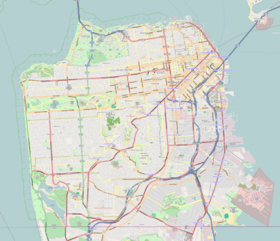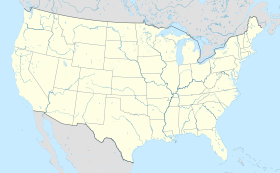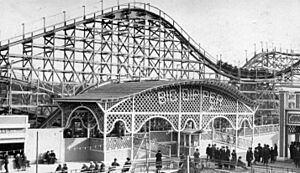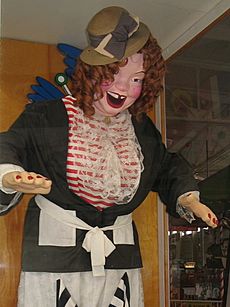Playland (San Francisco) facts for kids
| Previously known as Mooneysville-by-the-Sea, Chutes at the Beach, Playland at the Beach, Whitney's Playland | |
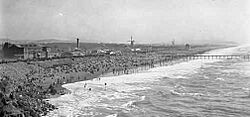
Playland in 1918
|
|
| Location | Ocean Beach San Francisco, California |
|---|---|
| Coordinates | 37°46′24″N 122°30′43″W / 37.77333°N 122.51194°W |
| Status | Closed |
| Opened | 1913 |
| Closed | 1972 |
| Area | 10 acres (40,000 m2) |
Playland was a famous seaside amusement park in San Francisco, California. It was also known as Playland at the Beach or Whitney's Playland. The park was about 10-acre (40,000 m2) big. It was located right next to Ocean Beach, along the Great Highway.
Playland started small in the late 1800s. It grew from a few rides and food stands. By 1913, it was known as Chutes at the Beach. The park was a popular spot for families and fun. Playland closed its doors for good in 1972.
Contents
Discovering Playland's Past
How Playland Began
The area where Playland stood was first a small settlement. It was called "Mooneysville-by-the-Sea." In 1884, a steam railroad brought people to the beach. They came to ride the first roller coaster there. It was called the "Gravity Railroad." People also visited the Ocean Beach Pavilion for music and dancing.
By 1890, trolley lines reached Ocean Beach. This made it easy for more people to visit. It helped the area grow into a trolley park. Famous places like the Cliff House (opened 1863) and Sutro Baths (opened 1896) attracted many visitors.
Early Rides and Fun
The first rides and attractions at the beach were owned by different people. These owners were called concessionaires. For example, John Friedle owned a shooting gallery. He also had a baseball-throwing game. Many rides at Chutes at the Beach were new. Some were built right there. The "Shoot-the-Chutes" ride was very popular. It even gave the park its first official name: Chutes at the Beach.
Around 1913, Arthur Looff rented land for a carousel. This was the Looff Hippodrome. It was next to John Friedle's stands. Friedle and Looff became partners. They wanted to create "the grandest amusement park on the Pacific coast." By 1921, they had ten rides. These included the Shoot-the-Chutes. A newspaper reported that by 1921, owners spent $150,000 on new rides. These were "clean, safe, moral attractions." They were open from noon to midnight every day.
Popular rides included Arthur Looff’s "Bob Sled Dipper" roller coaster (1921). There was also the Big Dipper roller coaster (1922). Other rides were the Shoot-the-Chutes, the carousel, and the Aeroplane Swing. The Whip, Dodg 'Em, Ship of Joy, and Ferris wheel were also there. Noah’s Ark was another favorite. The park had almost 100 food and game stands.
In 1923, brothers George and Leo Whitney arrived. They opened a photo stand. They had a new way to develop photos quickly. This meant people could take their pictures home right away. By 1924, the Whitney brothers owned four shooting galleries. They also had a souvenir shop.
The Rise of Playland
In 1926, George Whitney became the main manager. He changed the park's name to Playland-at-the-Beach. It was also sometimes called Whitney's at the Beach. Even though rides were still run by different owners, the Whitneys started buying them. This happened a lot during the Great Depression in the 1930s. Many smaller businesses struggled.
The Whitneys bought the roller coaster in 1936. They bought the merry-go-round in 1942. Playland grew to cover three city blocks. By 1934, the main area had 14 rides. It also had 25 food and game stands. There were 4 restaurants too.
The Whitneys eventually bought the land under Playland. They also bought nearby lots to expand. In 1937, George Whitney, Sr. bought the Cliff House. He reopened it as a fancy restaurant. George Whitney was known as "The Barnum of the Golden Gate." He bought many of the park's businesses. He even bought the Sutro Baths in 1952. He ran the park by himself after 1952 until he passed away in 1958.
After George Whitney died, Playland slowly changed. The Shoot the Chutes ride was taken down in 1950. The Big Dipper was removed in 1955. His son, George K. Whitney, Jr., ran the park for a while. Then, a developer named Bob Fraser took over. Playland was sold in 1971 to Jeremy Ets-Hokin. It was torn down on September 4, 1972. Today, apartments stand where Playland once was. A special art project remembers the park.
Exciting Playland Attractions
By 1922, Playland had many fun rides. These included Arthur Looff’s “Bob Sled Dipper.” There was also the Big Dipper, the Shoot-the-chutes, and the carousel. Other rides were the Aeroplane Swing, The Whip, Dodg 'Em (bumper cars), and the Ship of Joy. The Ferris wheel and Noah’s Ark were also popular. The park had almost 100 food and game stands.
Over the years, Playland added more rides. Some of these were Skyliner, Rocketship, and Big Slide. There was also Limbo (a dark house) and Kookie Kube. Dark Mystery was a spooky dark ride. It was later changed to look surreal. The Mad Mine was another dark ride. Other rides included Scrambler, Twister, and Kiddie Bulgy.
A special ride was the Diving Bell. This was a metal room that took guests underwater. It then brought them back up with a big splash! This ride first appeared at a big fair in 1939. George Whitney had another one built at Playland. It stayed until the park closed in 1972.
The Carousel Ride
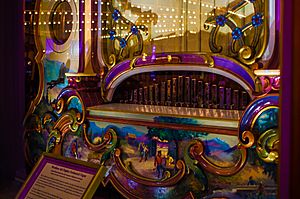
Arthur Looff ordered this carousel in 1904. It was meant for another park in San Francisco. But after the 1906 San Francisco earthquake, it went to Seattle. In 1913, Looff brought the carousel to Playland. It was placed in the Looff Hippodrome. This was the first permanent attraction at Chutes-at-the-Beach in 1914.
The carousel was beautiful. It had 68 horses. It also had a very expensive organ. This organ cost $5,000, which was a huge amount back then! Today, you can see and hear this 1914 Wurlitzer organ. It is at the Santa Cruz Beach Boardwalk's carousel house.
When Playland closed in 1972, the carousel was sold. A collector bought it and stored it in New Mexico. In 1984, the city of Long Beach, California bought it. San Francisco bought it in 1998. Now, the carousel is in Yerba Buena Gardens in downtown San Francisco.
The Fun House
The Fun House was one of Playland's most popular attractions. It was first called the Bug House. It opened in 1923-24. Laffing Sal was a famous laughing robot. Her loud laugh filled the park. After Playland closed, one of these robots went to the Santa Cruz Beach Boardwalk. The Laffing Sal from Playland's Fun House is now at the Musée Mécanique in San Francisco.
To enter the Fun House, you first walked through a mirror maze. Then, you went through spin-dryers. The main area had a Joy Wheel. This was a flat disc that spun fast. It made kids slide off! There was also the Barrel of Laughs. This was a spinning wooden barrel you walked through. Moving Bridges went up and down. Rocking Horses bounced on springs. The Fun House also had air jets and wobbly walkways. There were steep, moving stairs. You could climb three stories to the top of a huge indoor slide. This slide was 200-foot (61 m) long!
A famous scene from the movie The Lady from Shanghai (1948) was filmed at Playland. The outside shot of the Fun House in the movie was taken there.
Fun-Tier Town
Playland also had a special area for younger kids. It was called “Fun-tier” Town. This area had a western theme. It had ten rides made for children. It was also a place where kids could have birthday parties.
Camera Obscura
The Giant Camera Obscura was built in 1948–49. It was part of the Playland amusement area. A camera obscura is a device that uses light to project an image. When Playland closed, it moved next to the Cliff House.
Playland's Roller Coasters
- Figure-8: This roller coaster opened in 1920. It was replaced by the Big Dipper in 1922.
- Bob Sled Dipper: Opened in 1921, this ride was like a toboggan. Riders sat in cars linked together. It closed in 1929 after an accident. This ride was also called The Grizzly.
- Big Dipper: This coaster opened in 1922. It had a thrilling 80-foot drop. It was taken down in 1956. There was an accident on this ride.
- Sleigh Ride: Another fun coaster at the park.
- Alpine Racer: This ride operated from 1959 to 1972. It was a "wild mouse" style coaster from Germany.
Topsy’s Roost Restaurant
In 1929, George Whitney moved Topsy's Roost. This was a popular restaurant known for its chicken. It was moved into the old Ocean Beach Pavilion. This building was just north of Playland. Topsy's Roost became more than just a restaurant. It was also a popular nightclub. It had a live orchestra and a dance floor. The restaurant was decorated to look like chicken coops. You could sit on the main floor or on a balcony. People on the balcony could slide down to the dance floor!
By the mid-1930s, Whitney closed Topsy’s Roost. He focused on the Cliff House restaurant instead. The Topsy's Roost building later became other places. These included the Edgewater Ballroom and a slot car raceway. In 1947, Skateland, a roller rink, was built nearby.
Tasty Treats at Playland
The famous It's-It ice cream sandwich was created in 1928. George Whitney invented it! Until 1968, you could only buy It's-It at Playland-at-the-Beach. After Playland was torn down in 1972, It's-It started being sold elsewhere. Now, you can find it in stores in many states.


